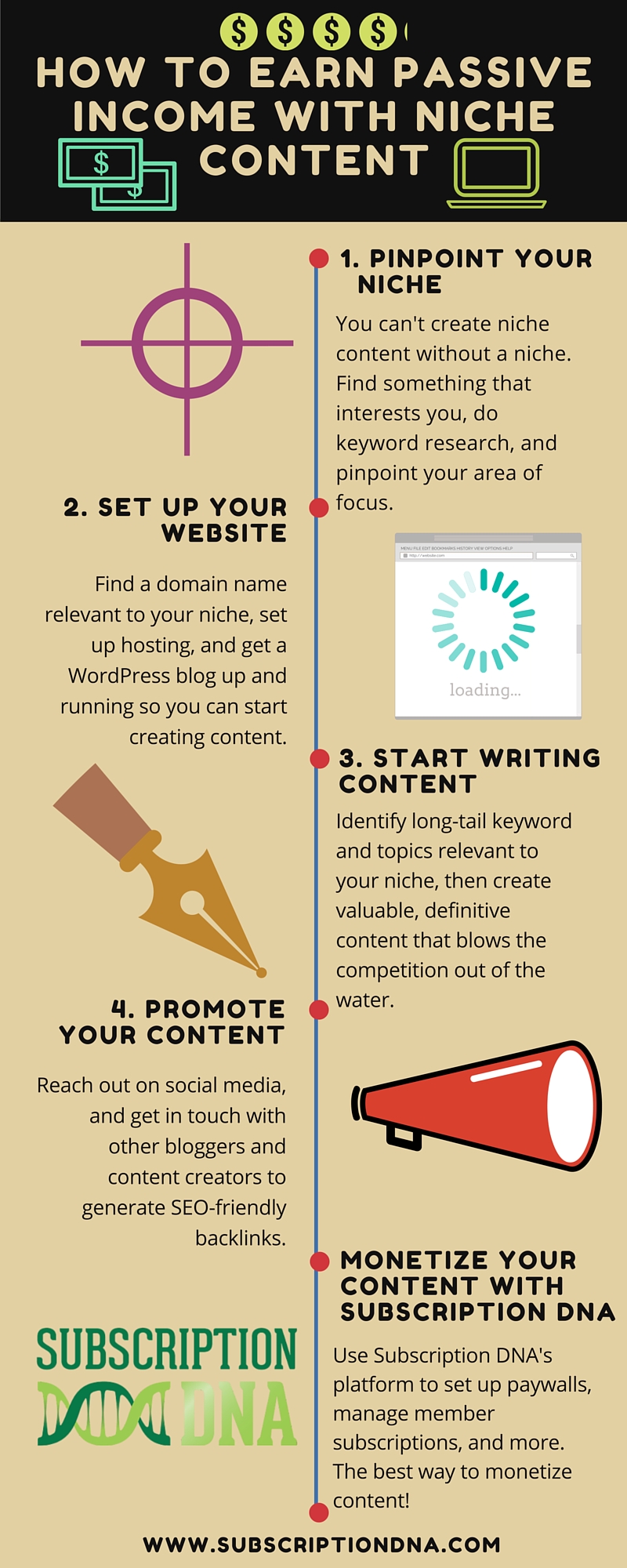Earning steady passive income is a pipe dream for many people, but that doesn’t make it out of reach for most people. Quite the opposite – anyone with an internet connection and a bit of free time can make a decent amount of passive income by creating and monetizing online content targeted at a highly specific demographic on what’s known as a “niche website.”
There are plenty of case studies and guides online about niche website ideas and other ways to earn passive income online, but this post is meant to provide a brief primer for people just getting started. Check out our infographic and the content below to learn more about generating smart passive income!
Embed this Infographic on Your Site:
<a href=”https://www.subscriptiondna.com/blog/infographic-earn-passive-income-niche-website/”><img src=”https://www.subscriptiondna.com/wp-content/uploads/2016/06/INFOGRAPHIC-How-to-Make-Passive-Income-with-Niche-Content.jpg” title=”INFOGRAPHIC: How to Earn Passive Income with a Niche Website” alt=”INFOGRAPHIC: How to Earn Passive Income with a Niche Website” width=”800″ height=”2000″></a>
Basic Terminology
What is Passive Income?
Passive income is money that regularly comes in with little effort on your part. Your paycheck from work doesn’t count as passive income because, well, you have to go to work to get it. Income you get from an investment, or a rental property, or interest on a bank account to cite three examples would be considered passive because all you have to do is wait for the check to show up (even if it took some startup work to get the ball rolling).
What is Niche Content?
Niche markets existed long before the internet. Niche markets are those defined by consumers with a particular, often very unique set of interests. This can be based on where they live, what their job is, what their hobbies are, their demographics, and countless other factors.
Niche content and niche websites are simply sites that are designed to cater to a specific niche. If you find one that’s underserved, it can be relatively easy to make a name for yourself.
Examples of niches might include retired firefighters, cyclists in Peoria, Iowa, people who collect antique straight razors, and countless other examples.
Getting Started: Identifying a Niche
The first step in making money with a niche website is identifying your niche. As with many other processes, this first step can often seem like the most daunting. The Smart Passive Income blog suggests getting started by creating a list of seven of your passions, seven of your problems, and seven of your fears. Then, looking at that list you can narrow things down to a list of ten possible avenues to explore.
The goal is to find a niche that’s not too obscure, but not so popular or well-known that the market is already saturated with content. You find this sweet spot by doing what’s called “keyword research” based on the list you put together above. Backlinko has what’s maybe the definitive guide to keyword research online.
For example, let’s say one of your passions is watching professional bull riding on television. When performing keyword research surrounding “professional bull riding,” you stumble on the keyword, “how to become a professional bull rider.” It gets a fair amount of traffic, but there’s relatively little content out there on the subject. You’ve just identified a decent niche: people who want to become professional bull riders.
Set Up Your Website
Now that you’ve identified your niche, it’s time to get your website up and running. Find an available domain name that’s based on your niche by using www.domainsbot.com. To continue with our example, we’ve just found out that becomeaprobullrider.com is available. Click the Buy button and a popup will give you several options for registering and hosting your domain. We don’t recommend any particular hosting company, but GoDaddy and HostGator are two of the most popular.
Once you’ve purchased your domain and set up hosting, there are a number of ways to get your new site live. WordPress is one of the most popular options, and for good reason. It’s versatile, search engines like it (SEO, or search engine optimization, will be a big part of your efforts), and it’s relatively user friendly. The hosting company you decide on should be able to walk you through the process of getting your blog set up.
From there, it’s a matter of making your site look the way you want and making sure you have all the right tools you’ll need. There are some valuable resources below on this front, but there are plenty more out there if you do a little searching.
- SiteGround’s WordPress Tutorial
- WebsiteSetup.org
- How to Launch a Self-Hosted WordPress Blog in 20 Minutes or Less by Michael Hyatt
Start Creating & Promoting Your Niche Content
Now comes the fun part – actually creating your content. There are a couple of ways you can go about this: You can outsource, or you can write your content yourself. But if you’re willing to go to all this trouble for a little passive income, odds are you might not have a ton of startup cash on-hand. That means it’s going to fall on you to write your own content.
Brainstorm ideas about what topics will appeal to people in your niche. These will be your target keywords. So for our example niche, people who want to become professional bull riders, topics/target keywords might include:
- How to become a professional bull rider (see above)
- How to get into PBR
- How long will I have to train to become a professional bull rider?
- How old do I have to be to become a professional bull rider?
Keyword research will reveal the best target keywords and content topics. Creating good niche, SEO-friendly content is easier said than done though. For each of your topics your ultimate goal will be to create what’s undisputedly the best piece of content on the internet on that subject. Scope out the competition, and do the best one better. Here are some great resources:
- Content & Search Engine Success Factors at Search Engine Land
- WordStream’s “What is SEO Content?”
- Turning Keywords into SEO Content by Backlinko
- SEO Copywriting by Neil Patel
Once your content is created (and it should be an ongoing process, for the most part), it’s time to start promoting. Social media like Facebook and Twitter are good ways to go about this, but your real endgame should be getting people to create links from their site to yours. In SEO these are called backlinks, and the process of getting them is called link outreach. Resources are below:
- Importance of Backlinks for SEO at SEOMastering.com
- BuzzStream’s Essential Guide to Effective Link Building Outreach
- PageOnePower’s Complete Guide to Outreach: 52 Curated Resources
- Link Building: The Definitive Guide by Backlinko
Monetize Your Content with Subscription DNA
Okay, so you’ve got your niche, your site, your content, and plenty of people reading it. Now, when does the income start to passively come in?
For this to happen you have to monetize your content. The most obvious way to do this is to install banner ads on your website using a service like Google AdSense, but as we’ve demonstrated before, this won’t exactly leave you with a bursting wallet.
No, the best way to monetize your online content is by using a premium content model. Basically, you offer some content for free, but more desirable, informative, and overall valuable content for a price. Your paid, or premium, content could be in the form of a definitive guide, an e-book, a white paper, and podcast, and more. Payment models could be one-off, or a regular membership model. This isn’t necessarily mutually exclusive with ads, but if you have to choose, go with premium content.
Subscription DNA is an online platform (with a convenient WordPress plugin) that lets you monetize your content with paywalls, member areas, automated recurring billing, and more. If you’re really serious about monetizing your niche content, you need Subscription DNA. Get in touch using the form below to learn more. More information on our blog:
- The Pros and Cons of Paywalls for Monetizing Online Content
- How to Make & Monetize an Educational Website (Without Ads!)
- How to Monetize Your Blog with Premium Content (and Why It’s Better than Ads)

